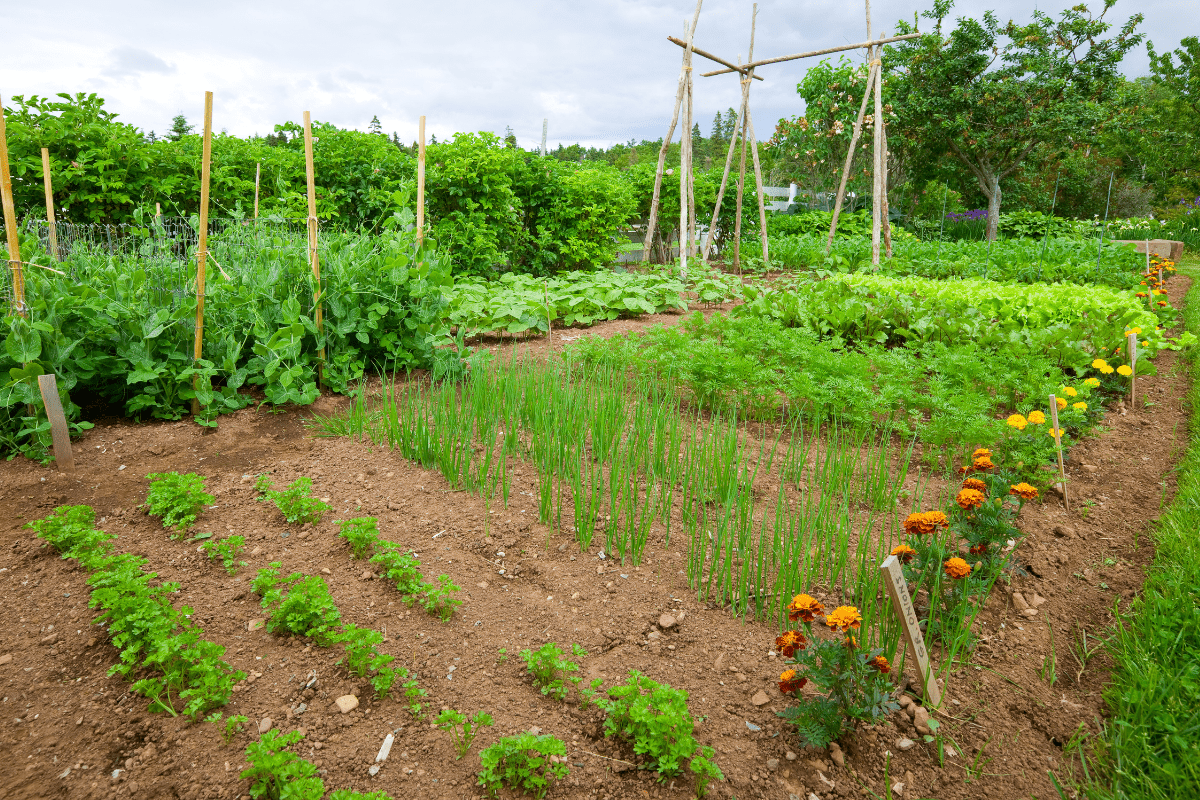If you've ever stood in the grocery store in February staring at rock-hard peaches that taste like disappointment, you already understand why seasonal eating matters. Illinois offers an incredible range of homegrown options throughout the year, from spring asparagus to winter storage crops, but knowing what grows when can feel like solving a particularly frustrating puzzle.
The dirt on Illinois growing conditions
Let's start with the foundation of it all: dirt. Illinois hit the soil lottery with some of the world's most fertile prairie soils. Our state soil, romantically named Drummer Silty Clay Loam, is basically the Beyoncé of dirt. It's deep, dark, and makes plants incredibly happy.
But here's where it gets tricky. Illinois stretches across multiple climate zones, from 5a up north (where Chicago gardeners pray their tomatoes ripen before Halloween) to 7b in the south (where folks are already harvesting while northerners are still wearing parkas). This means southern Illinois gardeners can start planting a full month earlier than their northern neighbors. If you're in central Illinois, congratulations… you've found the Goldilocks zone where most crops thrive without too much drama.
The state's 170-day growing season sounds generous until you realize that includes both "technically alive but not happy" early spring days and "please just ripen already" late fall moments. Understanding your specific microclimate matters more than following generic planting calendars, which brings us to the seasonal breakdown you've been waiting for.
Spring: When hope springs eternal (and so do weeds)
Early bloomers and edible experiments
Spring in Illinois starts whenever it feels like it, which could be February or April depending on the year's mood. The earliest signs include skunk cabbage, which literally generates its own heat to melt through snow. Show-off plant behavior aside, this is followed by prettier spring ephemerals like bloodroot and Virginia bluebells that carpet woodland floors before the trees leaf out.
For vegetable gardeners, spring belongs to the cool-season crowd. These tough characters can handle temperatures down to 25-28°F, which is good because Illinois spring weather has commitment issues. Your best bets for early planting include:
- Peas (sugar snap, snow, shelling)
- Spinach and lettuce varieties
- Radishes (ready in 25 days!)
- Onion sets and garlic
- Asparagus crowns (15-20 year investment)
- Rhubarb (for pie emergencies)
The secret weapon of spring gardening? Succession planting. Instead of planting all your lettuce at once and ending up with 47 heads ready the same week, plant a new row every two weeks. This works especially well for radishes, which grow so fast you'll wonder if they're on steroids.
Finding spring's early treasures
Farmers markets start tentatively reopening in April and May, with vendors huddled behind tables looking slightly hypothermic but determinedly cheerful. Chicago's Green City Market kicks off its outdoor season in April, though "outdoor" is a relative term when everyone's still wearing winter coats.
Early season offerings tend toward greenhouse greens, overwintered root vegetables (last year's potatoes looking surprisingly perky), and the season's first strawberries if we're lucky. CSA shares this time of year are like mystery boxes… heavy on the greens, light on variety, but after a winter of shipped produce, that first bunch of local spinach tastes like victory.
Summer: Nature's all-you-can-grow buffet
The pollinator party season
Summer is when Illinois gardens transform into pollinator paradise. Native flowers like purple coneflowers, black-eyed Susans, and wild bergamot don't just look pretty… they're essentially running a 24/7 buffet for bees and butterflies. Plant joe-pye weed and blazing star for late-summer monarch support, and you'll have front-row seats to nature's most impressive migration.
The best part about native plants? Once established, they're basically the houseplants of the outdoor world… nearly impossible to kill. They've evolved here, so they're already prepared for whatever weather nonsense Illinois throws at them.
Fruit season makes everything worthwhile
Nothing says summer like juice dripping down your chin at a pick-your-own farm. Strawberry season typically peaks in mid-June, with places like Stade's Farm in McHenry offering 20+ acres of berries. Pro tip: go early in the morning before the sun turns the field into a giant outdoor oven.
July brings raspberries and blueberries, though fair warning… blueberries are divas in Illinois. They want acidic soil, and our naturally alkaline dirt requires amendments and sulking before they'll produce. Peaches, on the other hand, love southern Illinois. Varieties like 'Redhaven' and 'Harbelle' prove you don't need to live in Georgia to grow amazing stone fruit.
The vegetable avalanche begins
June marks the great transition from "please grow faster" cool-season crops to "please slow down" warm-season abundance. This is when Illinois produces nearly $500 million worth of specialty crops annually, and your garden will feel like it's contributing at least half of that.
Tomatoes dominate most gardens because we're all eternal optimists who plant way too many. Disease-resistant varieties like 'Celebrity' and 'Jetstar' handle Illinois' humid summers better than heirlooms, though we still plant those beautiful heirlooms anyway because hope springs eternal. The key to summer planting success? Wait until soil reaches 60°F before planting heat lovers. Your tomatoes will thank you by not immediately getting every disease known to nightshades.
Sweet corn deserves its own paragraph because it's basically Illinois' vegetable mascot. Plant a new block every two weeks from July through early August for continuous harvests. Yes, you'll have corn coming out of your ears (pun intended), but freezing sweet corn is easier than explaining to your neighbors why you didn't share.
Fall: The second spring (but better)
Flowers that party until frost
Fall might be Illinois' best-kept gardening secret. While everyone else is sadly pulling up dead tomato vines, smart gardeners know this is actually the second spring… with fewer bugs and more predictable weather. Native asters and goldenrods burst into bloom just when you thought the flower show was over.
Quick PSA: goldenrod doesn't cause hay fever. That's ragweed blooming at the same time, trying to ruin goldenrod's reputation. Goldenrod is actually a pollinator superhero, feeding beneficial insects that help control garden pests. Plant it proudly and correct your sneezing neighbors.
Apple season and pumpkin everything
Nothing says fall in Illinois like apple orchards. Northern Illinois excels at growing storage-friendly varieties like 'Honeycrisp' and 'Liberty' that actually taste like apples instead of mealy disappointment. Orchards become destinations, with places like Honey Hill Orchard in Waterman combining picking with corn mazes, cider donuts, and other activities designed to extract maximum dollars from city folks seeking "authentic" farm experiences.
This is also prime time for winter squash, sweet potatoes, and other storage crops. Properly cured butternut squash lasts 3-4 months when stored at 50-55°F, which means you can still be eating local produce while snow covers the ground. It's like meal prepping, but the plants do most of the work.
The cool-season comeback
September offers a second chance at all those spring crops that bolted when summer arrived too fast. Fall-planted lettuce, spinach, and kale often outperform their spring counterparts because:
- Pest pressure drops dramatically
- Consistent moisture (usually) returns
- Cool nights enhance flavor
- You're less distracted by tomatoes
Many vegetables actually improve after frost exposure. Kale becomes sweeter, Brussels sprouts lose their bitterness, and carrots convert starches to sugars. It's like nature's way of rewarding patient gardeners.
Finding your local food tribe
The farmers market scene
Illinois farmers markets range from tiny town squares with three vendors to Chicago's extensive network of 20+ neighborhood markets. Green City Market operates year-round, though winter markets test everyone's dedication to local eating when it's 10 degrees outside.
Most markets now accept LINK/SNAP benefits with double-value programs, making fresh produce accessible regardless of income. This is huge for food justice and helps ensure everyone can access the nutrition and community connections that farmers markets provide.
CSA: The subscription box that predates subscription boxes
Community Supported Agriculture pioneered the whole "surprise box of stuff showing up regularly" concept long before meal kits were cool. Nichols Farm & Orchard, farming since 1978, delivers to 40+ Chicago-area locations with shares ranging from $840-1,800 for the season.
CSAs require commitment and vegetable creativity. You will receive more kohlrabi than you know what to do with. You will google "what is kohlrabi" at least once. But you'll also eat more diversely than ever and develop favorite vegetables you didn't know existed. Winter CSAs prove that seasonal eating doesn't stop with frost, featuring storage vegetables, greenhouse greens, and enough root vegetables to make you appreciate carrots in ways you never imagined.
Pick-your-own adventures
U-pick farms offer both produce and experiences, which explains why they can charge $25 for a wagon ride to a pumpkin patch. But there's something deeply satisfying about harvesting your own food, even if you're paying tourist prices for the privilege.
Northern Illinois offers everything from strawberry fields to apple orchards, while southern Illinois' Eckert's has grown from a 1910 roadside stand into an agricultural theme park. The key to u-pick success:
- Go early or late to avoid crowds
- Bring cash (many are still old-school)
- Dress for mud and sun
- Pick more than you think you need
- Accept that you'll eat half before leaving
Growing your own: From windowsill to homestead
Container gardens for the space-challenged
Not everyone has acre upon acre for growing, but that doesn't mean you can't join the seasonal eating party. Container gardening works surprisingly well for many crops. A single 'Patio' tomato plant in a 3-gallon pot can produce enough tomatoes for fresh eating all summer. Lettuce grows happily in window boxes, and herbs thrive in any sunny spot.
The key to container success:
- Choose compact varieties bred for containers
- Water more frequently than ground gardens
- Use quality potting mix (not garden soil)
- Practice succession planting for continuous harvest
Timing: The difference between abundance and heartbreak
Success in Illinois gardens depends less on having a green thumb and more on understanding timing. Cool-season crops planted too late bolt faster than a spooked rabbit. Warm-season plants set out before soil warms properly will sulk like teenagers asked to do chores.
The University of Illinois Extension provides detailed planting calendars, but the real secret is monitoring soil temperature. Get a soil thermometer and ignore the calendar. Your plants care about soil temperature, not what date the seed packet suggests.
Choosing varieties: Disease resistance over Instagram appeal
Those gorgeous heirloom tomatoes on Instagram? They'll probably die dramatically in Illinois' humid summers. Instead, choose disease-resistant varieties like 'Liberty' apples and 'Success PM' squash that handle our climate's mood swings. Native plants require minimal care once established, making them perfect for beginning gardeners or anyone who forgets to water.
Making seasonal abundance last
Storage without a root cellar
Our great-grandparents had root cellars, but most of us make do with basements, garages, or that weird cold spot in the spare bedroom. Different crops need different conditions:
Cool and humid (32-40°F): Apples, carrots, beets, cabbage Cool and dry (50-55°F): Winter squash, sweet potatoes, onions Just above freezing: Potatoes in complete darkness
Carrots and parsnips can actually overwinter in the ground under heavy mulch, becoming sweeter as cold converts their starches to sugars. It's like having a refrigerator that improves the food while storing it.
Preservation: Your hedge against February
Freezing preserves nutrition better than canning for most vegetables. The trick is proper blanching: 2 minutes for chopped spinach, 3 minutes for green beans. Skip this step and you'll have freezer-burned mush by December.
Canning requires more equipment and precision but creates shelf-stable foods that don't require electricity. Water bath canning works for high-acid foods like tomato sauce and fruit preserves. Pressure canning safely preserves low-acid vegetables but requires following tested recipes exactly. This is not the time for creative interpretation.
Why seasonal eating actually matters
The nutrition factor nobody talks about
Here's a fun fact that'll ruin grocery store lettuce forever: it loses nearly 50% of its vitamin C within three days of harvest. Those pale tomatoes shipped from thousands of miles away? They have significantly less lycopene than vine-ripened local ones. Seasonal eating isn't just about supporting local farms… it's about actually getting the nutrition you're paying for.
Illinois' seasonal progression naturally provides what bodies need throughout the year. Spring's bitter greens support natural detoxification after heavy winter comfort foods. Summer fruits high in beta-carotenes protect skin during peak sun exposure. Fall's orange vegetables provide vitamin A for immune support entering cold season. It's like nature planned a year-long wellness program, and all we have to do is eat along with it.
The community connection
Farmers markets become social hubs where neighbors catch up and cultural food traditions merge. You'll find yourself in conversations about the best way to prepare kohlrabi with someone you've never met but who becomes your unofficial vegetable mentor. CSA pickup sites turn into impromptu recipe exchanges and community gatherings.
These connections matter more than we realize. In an increasingly disconnected world, seasonal eating creates natural gathering points and shared experiences. Plus, farmers are generally delightful people who will enthusiastically discuss tomato varieties for longer than seems humanly possible.
Winter: Not dead, just resting
The fourth season surprise
Winter doesn't end seasonal eating in Illinois… it just requires more creativity. Storage crops like potatoes, onions, and squash provide vegetable variety while frozen summer bounty brightens winter meals. Several farmers markets operate year-round, including Chicago's Green City Market, where vendors huddle next to heaters selling greenhouse greens and storage crops.
Winter CSAs demonstrate that "seasonal" doesn't mean "suffering." Shares might include purple potatoes, watermelon radishes, greenhouse lettuce, and various root vegetables you'll learn to love. These shares cost less than summer offerings while providing unique variety and the motivation to try new recipes when you're tired of roasted everything.
Indoor growing for the desperate
By February, even the most dedicated seasonal eater starts dreaming of fresh greens. This is where indoor growing saves sanity. Microgreens grow on a sunny windowsill in 7-10 days. Sprouting requires nothing but a jar and some seeds. It's not the same as August tomato abundance, but it maintains the connection to growing food when everything outside looks dead.
Getting started without overwhelming yourself
The key to sustainable seasonal eating is starting small. Visit a farmers market once a month. Try a small CSA share. Plant three tomato plants instead of fifteen. Build relationships with farmers who'll answer your endless questions about storage and preparation.
The economic benefits add up quickly. In-season produce typically costs 36% less than out-of-season alternatives. Factor in superior nutrition and flavor, and seasonal eating becomes the logical choice rather than the trendy one.
Most importantly, give yourself permission to be imperfect at this. You'll still buy bananas in January. You'll let CSA radishes go soft in the crisper drawer at least once. You'll plant zucchini and curse yourself later when you're sneaking bags onto neighbors' porches. This is all part of the seasonal eating journey, and it's still worth taking.
Illinois' agricultural abundance makes seasonal eating both practical and enjoyable. From March's optimistic asparagus to October's abundant apples and beyond, each season offers unique flavors and opportunities. Whether you garden, shop farmers markets, or join a CSA, seasonal eating connects you with the land, the seasons, and a community of people who understand that the best peach is the one that grew nearby and ripened in its own sweet time.





